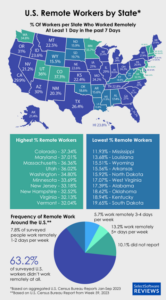
A recent analysis of data from the U.S. Census Bureau’s Household Pulse Survey highlights the vast regional differences within the U.S. regarding the percentage of the population working from home regularly.
The analysis, released recently by HR software advisory firm SelectSoftware Review, found Colorado (at 37%) has the most significant percentage of workers in 2023 regularly working from home at least one day a week. In contrast, 12% of workers in Mississippi work from home on a regular basis. That’s the lowest percentage in the nation.
The regional difference in remote work is based on a complex mix of factors, including the education levels of the population, real estate costs, commute length and types of occupations in the area. College graduates with “knowledge workers” careers are much more likely to work from home, as are higher-income households.
Andy Baker, chief people officer at virtual desktop management provider Nerdio, says companies likewise vary their level of remote workers based on their specific hiring needs and specific geographical characteristics. “As an HR leader in a technology company, we consider several factors when discussing the prevalence of remote workers in specific locations. The access to top talent with required skills and experience and the competitive job markets in these regions drives the need to use work from home as a strategic advantage in attracting and retaining skilled and experienced employees,” Baker says.
Baker also cites variables such as long-distance commutes and a company’s dedication to work/life balance for employees. “Regions with challenging traffic and long commute times should utilize work from home to reduce employee stress, increase productivity, and save on real estate/operation costs associated with having employees in an office. Also, the availability of high-speed internet and regions that have a strong technology infrastructure can allow a higher percentage of remote workers,” Baker says.
SelectSoftware Review’s analysis of Census data found that Utah had the most remote workers among Americans earning up to $25,000, at roughly 20%. Interestingly, North Dakota had the fewest of these remote workers, with 96% of staff never working from home. Their analysis also found that Massachusetts had the highest number of workers earning $200,000 or more working from home, with 81% of those high-earning residents regularly working remotely.
The data also shows that Americans ages 25 to 39, Millennials, work from home the most, and Massachusetts held the highest percentage of such remote workers at 48%.
Regarding educational background, Maryland has the highest percentage (59%) of Americans working from home in 2023 who have a bachelor’s degree or higher. In comparison, Utah has the highest rate of Americans whose education is a high school diploma who worked from home in 2023, at 23%. Twenty percent of staffers in the state with less than a high school education work from home.
Effective WFH Policies Necessary to Retail Talent
Despite many organizations developing return-to-office policies and asking employees to return in person, effective WFH policies, especially hybrid strategies, are essential to remaining competitive in many industries. “As we have all seen, the ability to work from home has opened organizations up to attract talent across geographic locations, increasing their ability to attract the most skilled talent available,” explains Nerdio’s Baker. “However, we’ve also seen company leaders desire employees to be back in person for at least part of the week, which can be seen as a way to improve company culture and retain local talent. The key is balance — understanding what your workforce needs to do their jobs well and putting policies that promote a productive, inclusive, and equitable employee experience for all.”
According to Kelly Berte, director of HR research and advisory services at McLean & Company, regardless of whether working from home full time or working in a hybrid arrangement, it’s the flexibility that staff seek. “Our research shows that employees are 3.7 times more likely to be engaged if they are satisfied with the workplace flexibility, with almost 40% of employees who work in fully remote or hybrid settings saying they would seek another job if their employer mandated a full-time return to the office policy. If some form of return to office is required by the organization, a hybrid policy is especially important for retaining employees who have been working fully remotely,” Berte says.
“The bottom line is simple: If an organization plans to transition to a hybrid model from fully remote, the organization must have a strong rationale for doing so or else risk decreased employee engagement and increased retention challenges,” Berte warns.
Baker contends remote work is here to stay. “Ninety-eight percent of workers want to work remotely at least some of the time. In a recent Dice report, 60% of tech professionals ranked 100% remote work as their “most desired workplace setting.” All of this is to say that it’s not only important to have a remote work policy set in place, but also to continue to revisit and evolve it based on the business needs,” Baker says.

